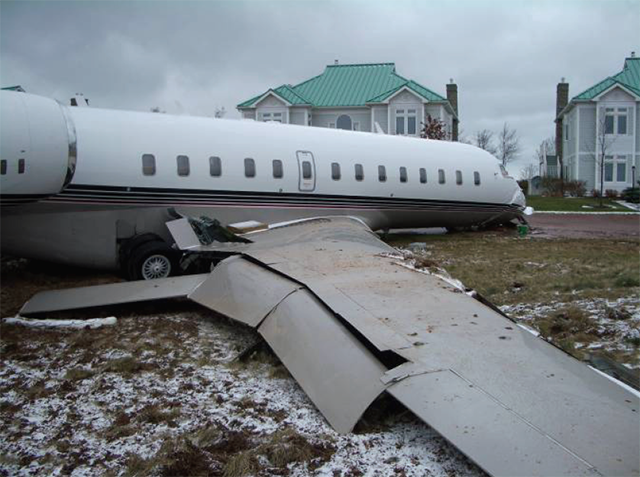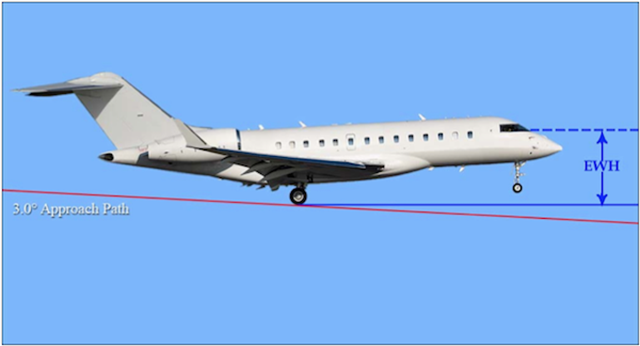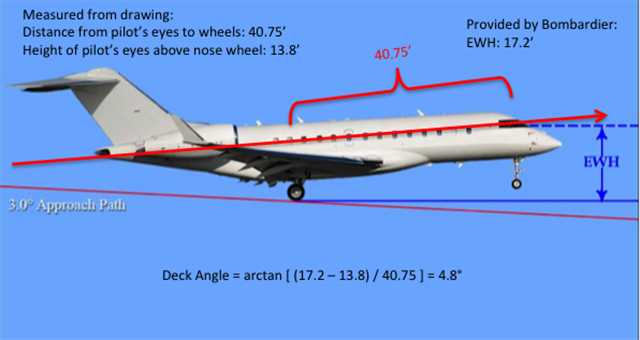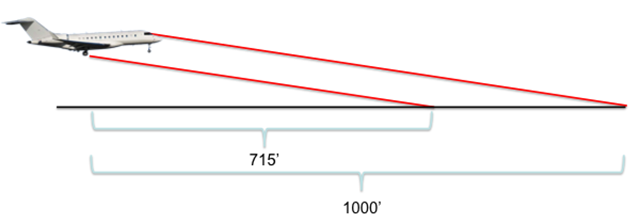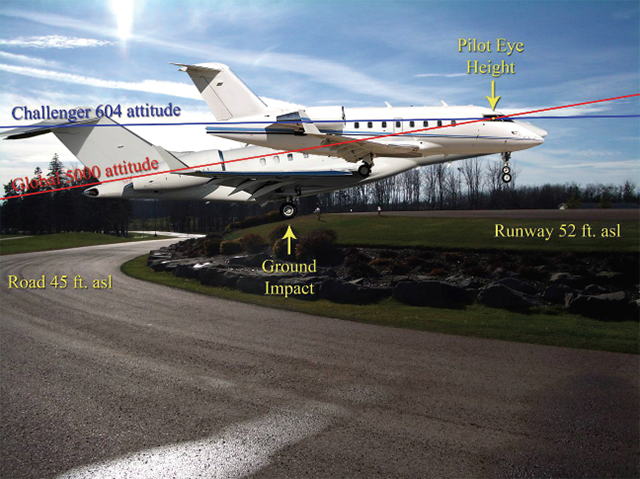This is a classic mishap where aiming for the first inch of pavement leads to bad results. Ever since one of my Air Force Boeing 747 squadron mates put eighteen wheel prints in the overrun at Andrews, the math behind aircraft deck angle has been a priority for me. What the Canada Transportation Safety Board calls "Eye-to-wheel height" really misses the point. What pilots really need to understand is how far behind their aim point the wheels will contact the runway. The geometry of the aircraft on approach fundamentally changes the point at which the wheels will touch in relation to the pilot's aim point. The pilots were experienced in the Challenger 604, which has an abnormally flat deck angle on approach. In that airplane, they were able to successfully aim for 500 feet down the runway and land fairly close to that target. In an airplane with a higher deck angle, such as the incident's BD-700, this is not possible.
— James Albright

Updated:
2014-06-13
In this model of BD-700 the main gear are 41 feet behind the pilots, but the wheels will touch 285' behind the pilot's aim point if the pilot does not flare. Hard to believe? See Deck Angle for the math.

1
Accident report
- Date: 11 NOV 2007
- Time: 14:34
- Type: Bombardier BD-700-1A11 Global 5000
- Operator: Jetport Inc.
- Registration: C-GXPR
- Fatalities: 0 of 2 crew, 0 of 8 passengers
- Aircraft Fate: Damaged beyond repair (the cockpit is now part of a flight simulator)
- Phase: Landing
- Airport: (Departure) Hamilton Airport, ON (YHM/CYHM), Canada
- Airport: (Destination) Fox Harbour Airport, NS, Canada
2
Narrative
Approaching the destination, the crew completed the approach and landing briefing. Because a damp runway and a crosswind were expected, they planned a firm touchdown followed by use of reverse thrust. The autobrake system has settings of low, medium or high. For passenger comfort, the autobrake system was selected on the low setting. In order to maximize the available roll-out distance, the touchdown point was planned for the first 500 feet of runway, the same distance this crew had used in the past when flying into CFH4 with other company aircraft. The captain had verified the landing distance performance and had estimated that, for the conditions, 4300 feet of the 4885-foot runway was required.
Source: Aviation Investigation Report A07A0134, §1.1
There are few contradictory ideas here. They computed a landing distance of 4300 feet, which would have included a 50 foot threshold crossing height, yet they planned on crossing the threshold below that height. They planned a firm touchdown, but selected the lowest setting of the autobrakes.
- At 1430:53, five nautical miles (nm) from the threshold of Runway 33, the aircraft crossed the final approach fix at an altitude of 1680 feet above sea level (asl). At that point, the crew had the runway in sight. At 4.4 nm, the APAPI was visible to the crew. At this time, the aircraft was configured for landing and stabilized on approach, following FMS vertical path guidance.
- At 1433:27 (T-58), approximately 550 feet above the runway elevation and 1.4 nm from the threshold, the PF disconnected the autopilot and flew the approach manually, leveling off momentarily.
- At 1433:38 (T-47), approximately 500 feet above the runway elevation and 1.1 nm from the threshold, the PNF called a deviation above the APAPI guidance and the PF corrected the flight path by increasing the descent rate to intercept the APAPI approach slope. At this point, the PNF switched his attention from monitoring the approach to searching for signs of wildlife because, in the previous week, there had been numerous deer in the vicinity of and on the runway.
- At 1433:50 (T-35), approximately 350 feet above the runway elevation and 0.85 nm from the threshold, the aircraft intercepted the 3.0° APAPI path. At the same time, the PF began using the wing-low, crosswind landing technique. The right wing was lowered and left rudder was applied to maintain track. From this point on and until touchdown, the PF was using aileron and rudder input to maintain track. At this time, there was a 28-knot headwind and an 18-knot crosswind.
- At 1433:57 (T-28), approximately 250 feet above the runway elevation and 0.7 nm from the threshold, the airspeed was fluctuating between 105 and 120 knots.
- At 1434:05 (T-20), approximately 180 feet above the runway elevation and 0.5 nm from the threshold, the PF transitioned visually to the runway to assess the landing profile, and the aircraft descended below the APAPI on-slope indication. From this point on, even though the aircraft remained below the APAPI on-slope indication, no APAPI deviation calls were made.
- At 1434:15 (T-10), approximately 100 feet above the runway elevation, the wind had decreased slightly and was calculated as a 26-knot headwind component and a 12-knot crosswind component.
- At 1434:20 (T-5) and only 830 feet from the threshold, the aircraft radio altitude auto call-out system announced "50"; this is what the captain normally used as a prompt to begin the flare. The PF started raising the nose of the aircraft and was now using considerable aileron and rudder input. At this time, both engines were at 50 percent N1 rpm and the wind was calculated as a 21-knot headwind component and an 8-knot crosswind component.
Source: Aviation Investigation Report A07A0134, §1.1
The geometry of approach at the 50 foot call would indicate a 3.45° glide path — arctan (50 / 830) — if aiming for the first inch of pavement, but 2.33° — arctan (50 / 1230) — if aiming for the 500' point, as the pilot had intended. Either way, the approach could have worked under these circumstances, but there was no margin for error.
- At 1434:21 (T-4) and only 680 feet from the threshold, the autothrottle mode changed from the SPEED to the RETARD mode. This caused the thrust levers to automatically retard to the IDLE position. At this point on the approach, there was no recognition by the crew that the aircraft was on an unsafe flight path.
- At 1434:23 (T-2) and 360 feet from the threshold, the crew felt the aircraft sinking, and the airspeed decreased to 102 knots. The aircraft radio altitude auto call-out system announced "30". The PF increased the rate of pitch change, eventually reaching a nose-up attitude of 10.6°. At this time, the engines were at 38 per cent N1 rpm and still reducing, but no additional thrust was applied.
- At 1434:25, the aircraft touched down 7 feet 6 inches short of Runway 33 and 18 inches below the surface of the runway
- As the right main landing gear struck the edge of the runway surface, it collapsed. The initial impact triggered the emergency locator transmitter (ELT) as well as the cockpit voice recorder (CVR) acceleration switch, which ended the recording of crew exchanges.
- The aircraft continued down the runway with the right wing dragging. At 640 feet from the touchdown point, the aircraft departed the right side of the runway. It travelled across several earthen mounds and pivoted 120° to the right before coming to a stop.
Source: Aviation Investigation Report A07A0134, §1.1
3
Analysis
- The captain was certified and qualified for the flight in accordance with existing regulations. At the time of the accident, he had accumulated 9188 hours of total flying time, including 3196 hours on turbojets. In his previous employment, he had accumulated over 2500 hours as captain on a DHC-6 Twin Otter, over 1000 hours on a Beechcraft B200 and over 1000 hours as captain on a Westwind WW24 turbojet. Since joining Jetport Inc. (Jetport) on 24 July 2000, he had accumulated 2196 hours as captain on the Gulfstream G100 and Bombardier Challenger 604 (CL604).
- Before the occurrence flight, the captain had a total of 64 hours on the Global 5000, all flown on the occurrence aircraft (C-GXPR). The captain had flown other Jetport aircraft, including the CL604, into CFH4 approximately 75 times in the previous years. However, this was only his third landing in CFH4 at the controls of the Global 5000.
Source: Aviation Investigation Report A07A0134, §1.1
The mishap aircraft was the longest aircraft the captain had ever flown, it is unlikely he would have ever been taught about the distance between his aim point and wheel no-flare distance. His most formative jet experience was in the Challenger 604, which has an unusual landing geometry.
- The captain's first landing at CFH4 with the Global 5000 was on 21 October 2007, accompanied by the support pilot. The aircraft landing weight for that flight was 63,032 pounds, approximately 2,000 pounds heavier than on the occurrence flight. The ceiling and visibility were good and the winds were from the west at 13 knots gusting to 20 knots. The turbulent approach was flown manually from an altitude of 1200 feet asl and with the autothrottle engaged. The captain planned to touch down in the first 500 feet of runway, as he normally did in CFH4. The captain had just initiated the flare when the aircraft touched down, approximately 200 feet past the threshold, closer to the threshold than planned. This was debriefed by the support pilot.
- The first officer was certified and qualified for the flight in accordance with existing regulations. At the time of the accident, he had accumulated 6426 hours of total flying time. In his previous employment, he had accumulated over 2000 hours of flying light and heavy turboprop aircraft. Since joining Jetport in 2000, he had accumulated 3064 hours, of which 2540 hours were as captain, on the Gulfstream G100 and the CL604 turbojets.
- In July 2007, he completed the Global 5000 ground school and level D simulator training at the Bombardier Aerospace Training Centre in Saint-Laurent. On 03 August 2007, the first officer completed a CARs subpart 704 initial PPC monitored by a Transport Canada inspector. During training, the first officer accumulated 34 hours of level D simulator time.
Source: Aviation Investigation Report A07A0134, §1.1
C-GXPR's EWH calculations were completed using the actual conditions, an aerodrome at sea level, a 3.0° flight path and the landing gear fully extended. For the occurrence flight, the EWH was determined to be 16.35 feet. Based on the Global 5000 maximum landing weight of 78,600 pounds, the greatest EWH for the Global 5000 in the approach configuration was determined to be 17.2 feet.
Source: Aviation Investigation Report A07A0134, §1.9.4
Calculations were also completed by the manufacturer to obtain the EWH of the Bombardier Challenger 604 (CL604), assuming a 3.0° flight path, in both the light landing configuration and the heavy landing configuration. The EWH in the light landing configuration was calculated using a landing weight of 28,000 pounds and was determined to be 12.11 feet.
Source: Aviation Investigation Report A07A0134, §1.9.5
The difference in eye-to-wheel height of the two airplanes is a mere 5 feet. That might explain the difference between just barely clearing the runway's edge and hitting the runway's edge in this particular case, but it doesn't explain the reason the pilot's 500 feet aim point is inappropriate. We can do better. . .
The investigators failed to consider the distance between the pilot's aim point and the theoretical point the wheels would touchdown without a flare, based on that aim point. Because of the aircraft's positive deck angle and the height of the pilot's eyes above the wheels, the distance is not one-for-one. Few manufacturers publish their aircraft deck angles but it can be estimated. In the case of the BD-700, using a photo of the aircraft on approach in the accident report we can determine the BD-700 has an approach deck angle of 5°, which is typical of most passenger jets. (The pilots were most recently qualified on a Challenger 604, which is a notable exception to this average. The 604 has an approach angle which appears to be very close to zero.)
If a BD-700 pilot flies an on-speed 3° glide path toward an aim point on a runway and does not flare, the aircraft's wheels will touch the runway 285 feet behind that aim point. In the case of this mishap, the pilot was on track to do just that, but when the throttles went into the retard mode the aircraft was not over the runway and the pilot's pitch feel would have been different because there was less ground effect. The pilot failed to compensate and the airplane dipped below the glide slope he had set up.
The lesson should be clear: your wheels will touch far behind your aim point unless you flare consistently. You will be hard pressed to do that unless your airplane is over the runway when you flare. Aiming short of a normal 750' to 1,000' aim point removes all margin for error.
More about this: Aim Point versus Touchdown Point.
4
Cause
- The crew planned a touchdown point within the first 500 feet of the runway to maximize the available roll-out. This required crossing the threshold at a height lower than the manufacturer's recommended threshold crossing height (TCH).
- The flight crew members flew the approach profile as they had done in the past on the smaller Bombardier Challenger 604 (CL604), with no consideration for the Global 5000 greater aircraft eye-to-wheel height (EWH), resulting in a reduced TCH.
- The abbreviated precision approach path indicator (APAPI) guidance, although not appropriate for this aircraft type, would have assured a reduced main landing gear clearance of eight feet above threshold. At 0.5 nm, the pilot flying (PF) descended below the APAPI guidance, further reducing the TCH.
- The pilot used the wing-low crosswind technique, increasing his workload and resulting in pilot-induced oscillations.
- Both pilots' low experience on the Global 5000, combined with the PF's high workload, affected their ability to recognize the unsafe approach path and take appropriate corrective action.
- With the aircraft in a low energy state, the pitch up to 10.6º without an associated thrust increase could not correct the flight profile, resulting in the impact with the sloped surface before the runway threshold.
- The impact with the sloped surface initiated a sequence resulting in the collapse of the right main gear, a loss of directional control, the eventual departure from the runway surface, substantial damage to the aircraft, and some injuries.
- Contrary to the manufacturer's recommended practices, Jetport's standard operating procedures (SOPs) sanctioned descent under electronic or visual glide slope guidance, with a view to extending the landing distance available as acceptable and good airmanship; this contributed to the aircraft landing short of the runway.
- The lack of an effective transition from traditional safety management to a functional safety management system (SMS) as required by Jetport's private operator certificate (POC) prevented an adequate risk assessment of the introduction of the Global 5000 into its operations and contributed to the accident.
- An inappropriate balance of responsibilities for oversight between the regulator, its delegated agency, and the operator resulted in Jetport's inadequate risk assessment not being identified.
- C-GXPR's EWH calculations were completed using the actual conditions, an aerodrome at sea level, a 3.0° flight path and the landing gear fully extended. For the occurrence flight, the EWH was determined to be 16.35 feet. Based on the Global 5000 maximum landing weight of 78,600 pounds, the greatest EWH for the Global 5000 in the approach configuration was determined to be 17.2 feet.
- Calculations were also completed by the manufacturer to obtain the EWH of the Bombardier Challenger 604 (CL604), assuming a 3.0° flight path, in both the light landing configuration and the heavy landing configuration. The EWH in the light landing configuration was calculated using a landing weight of 28 000 pounds and was determined to be 12.11 feet
Source: Aviation Investigation Report A07A0134, §3.1
References
(Source material)
Transportation Safety Board of Canada, Aviation Investigation Report A07A0134, Touchdown Short of Runway, Jetport In., Bombardier BD-700-1A11 (Global 5000) C-GXPR, Fox Harbour Aerodrome, Nova Scotia, 11 November 2007.
